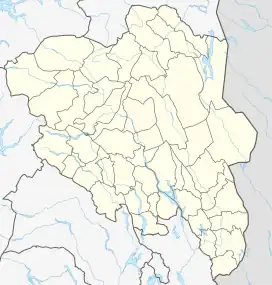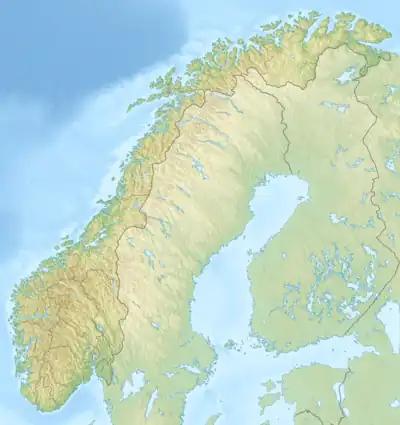| Juvvasshøi | |
|---|---|
| Juvvasshøe | |
 Juvvasshøi Location of the mountain  Juvvasshøi Juvvasshøi (Norway) | |
| Highest point | |
| Elevation | 1,893 m (6,211 ft)[1] |
| Prominence | 52 m (171 ft)[1] |
| Parent peak | Galdhøpiggen |
| Isolation | 0.869 km (0.540 mi)[1] |
| Coordinates | 61°40′39″N 8°22′07″E / 61.67749°N 8.36848°E[2] |
| Geography | |
| Location | Innlandet, Norway |
| Parent range | Jotunheimen |
| Topo map | 1518 II Galdhøpiggen |
Juvvasshøi or Juvvasshøe is a mountain in Lom Municipality in Innlandet county, Norway. The 1,893-metre (6,211 ft) tall mountain is located in the Jotunheimen mountains just outside the border of Jotunheimen National Park. The mountain sits about 20 kilometres (12 mi) southwest of the village of Fossbergom and about 50 kilometres (31 mi) northeast of the village of Øvre Årdal. The mountain is surrounded by several other notable mountains including Store Lauvhøi to the northeast, Glittertinden to the east, Galdhøi and Galdhøpiggen to the southwest, and Storhøi to the northwest.[1]
Climate and Permafrost in the Juvvasshøi area
The mean annual air temperature (MAAT) at Juvvasshøi is -4.1 °C. This value is extrapolated from a larger number of official Norwegian weather stations.[3] According to the experience in other alpine and polar regions this MAAT indicates that permafrost must be widespread and probably extends to a depth of several hundred meters. Within the EU-sponsored project PACE (Permafrost and Climate in Europe), a 129 meters deep vertical borehole in bedrock was drilled in August 1999 on Juvvasshøi at an altitude of 1893 meters above sea level.[4] The stable ground temperature at a depth of 100 meters is still -2.6 °C. The measured geothermal gradient in the drillhole of 1.19 °C/100 m allows to calculate a permafrost thickness of 320 meters, a proof that widespread permafrost occurrences must exist in the Jotunheimen area at these altitudes.
Juvvasshøi is surrounded by several other notable mountains of Jotunheimen including Glittertinden to the east, Galdhøi and Galdhøpiggen to the southwest.[1] They are even several hundred meters higher. The expected MAAT at these highest peaks is in the order of -7 °C, a value characteristic for areas with continuous permafrost and a considerable permafrost thickness. For many Scandinavian scientists, this was surprising and not accepted until the fifth International Conference on Permafrost (ICOP) in 1988 in Trondheim followed by field excursions in Norway and Sweden with international periglacial experts. However, the first permafrost findings date back to the 1970s and early 1980s when thick permafrost occurrences were proved with geophysical soundings.[5]
See also
References
- 1 2 3 4 5 "Juvvasshøi". PeakVisor.com. Retrieved 8 May 2022.
- ↑ "Juvvasshøe, Lom" (in Norwegian). yr.no. Retrieved 8 May 2022.
- ↑ King, Lorenz (1984). "Permafrost in Skandinavien - Untersuchungsergebnisse aus Lappland, Jotunheimen und Dovre/Rondane". Heidelberger Geographische Arbeiten (in German). 76: 174 pages.
- ↑ Harris, Charles; Haeberli, Wilfried; Vonder Mühll, Daniel; King, Lorenz (2001). "Permafrost Monitoring in the High Mountains of Europe: the PACE Project in its Global Context". Permafrost and Periglacial Processes. 12 (1): 3–11. doi:10.1002/ppp.377.
- ↑ King, Lorenz (1983). "High Mountain Permafrost in Scandinavia". Permafrost: Fourth International Conference, Proceedings: 612–617.